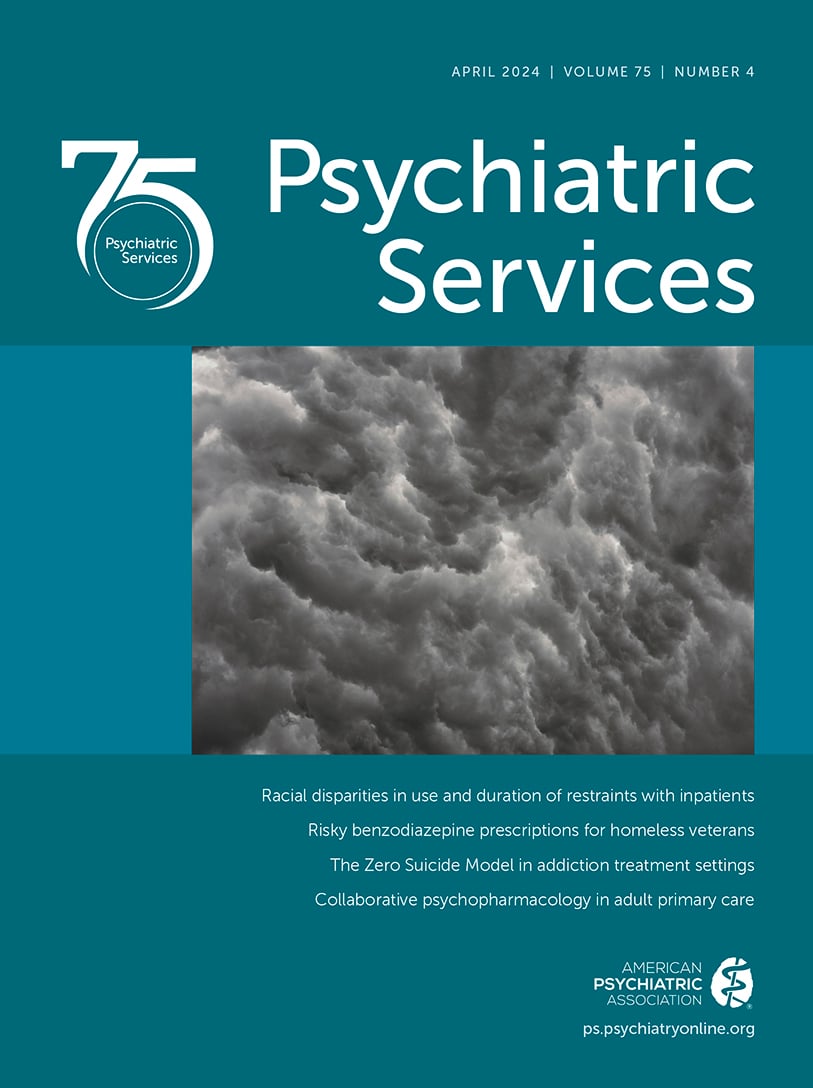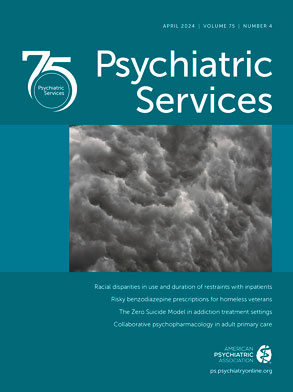Patients with substance use disorders face a significantly increased risk for suicide and self-harm. A study of U.S. Medicaid patients who accessed mental health clinic services reported that those with substance use disorders had more than three times the risk for intentional self-harm and suicide attempts compared with those without such disorders (adjusted OR [AOR]=3.4) (
1). In a study of men and women receiving Veterans Health Administration care, a substance use disorder diagnosis was associated with a 67% increase in the risk for suicide among men and 115% increase among women, even when psychiatric conditions were controlled for (
2). Furthermore, individuals with opioid use disorder have a suicide rate six times higher than that of those in the general U.S. population (
3). This pronounced risk underscores the pressing need for innovative solutions.
The Zero Suicide (ZS) Model
The ZS model is a strategy for suicide prevention and aspires to eliminate suicide among patients receiving care within health care systems (
4). ZS consists of seven tenets that provide best practices for suicide prevention. Some tenets focus on organizational change (Lead), such as workforce training (Train) and quality improvement (Improve), whereas others emphasize patient care and warm handoffs (Transition). Three elements directly target patient interactions, including consistent screening (Identify), safety planning (Engage), and evidence-based treatments (Treat) (
https://zerosuicide.edc.org/about/framework). The ZS model does not mandate specific tools, assessments, or treatments. Instead, it offers a comprehensive library of information and provides guidance on selecting context-appropriate strategies. This approach acknowledges the diversity of health care settings, patient populations, and clinician-patient relationships and allows for flexibility in tailoring an organization’s suicide prevention approach.
The ZS model has been shown to be associated with decreased suicide rates (
5,
6), but its implementation in addiction treatment settings has been limited. Consequently, we know little about its effectiveness in these settings and barriers to its implementation. By conducting further studies on ZS implementation in addiction settings, we can better understand the reasons behind its underutilization and explore its potential for reducing suicides in the high-risk population of people with substance use disorders.
ZS Implementation in Clinical Care
Pilot studies of ZS model implementation across multiple countries and treatment settings have indicated promising results. ZS’s landmark predecessor, the Perfect Depression Care Initiative, was associated with a 75% decrease in the average rate of annual suicides (
7). In one study of suicidal incidents across 110 community mental health clinics in New York State (
5), fidelity to ZS implementation was associated with a significant decrease in suicide attempts and suicides. Included clinics were predominantly urban (70%) and served adults (80%). Fidelity to the ZS model was self-assessed via the Zero Suicide Organizational Self-Study instrument, with a total average fidelity score of 3.1±0.6 (range 1.4–4.1). Each 1-point increase in a clinic’s fidelity score significantly reduced the likelihood of having a suicide event, including suicidal behaviors, suicide attempts, or completed suicide (AOR=0.31, 95% CI=0.14–0.69) (
5). An Australian observational study of 604 patients with 737 presentations of suicide attempt noted a 38% reduction in the risk for repeated suicide attempts within 90 days and a significantly extended period between repeated suicide attempts when the ZS model was applied (
6). Preliminary data from a study of patients in a nonprofit health care organization in Tennessee indicated that ZS implementation was associated with a 65% reduction in suicide rate, from 31 per 100,000 people to 11 per 100,000 (
8). These results indicate that ZS is a promising intervention, but it has been studied only in a limited number of settings.
Despite these encouraging numbers, research on ZS model implementation in inpatient or outpatient addiction treatment settings is lacking. As mentioned above, patients with substance use disorders have been included in ZS implementation studies (
5); however, the prevalence of patients with substance use disorders was not included in analyses. Therefore, ZS’s effectiveness in populations of individuals with such disorders remains uncertain, as is the potential for specific improvements of the model. Suicide prevention interventions are feasible and valuable in addiction settings: findings from a randomized controlled trial (
9) revealed that a single didactic presentation on suicide prevention in intensive outpatient programs could significantly improve knowledge about suicide and help-seeking behavior among individuals with substance use disorders. Importantly, no current clinical trials appear to be under way to assess ZS’s efficacy in addiction treatment settings.
ZS Implementation Barriers
Because of the dearth of data, we can only speculate about the barriers to the implementation of ZS in addiction treatment settings and research. One potential factor that may obscure understanding of such barriers is the “hidden suicides” phenomenon. Particularly for individuals with opioid use disorder, it is challenging to distinguish those who died from an unintentional overdose from those who died after a volitional overdose (
3,
10). In the absence of a suicide note, it can be nearly impossible for medical examiners to determine whether an overdose death was intentional. Therefore, the volition in many overdose deaths is classified as “undetermined” (
3). As a result, many overdose deaths deemed unintentional may have been unidentified suicides (
2). The true proportion of suicides among instances of opioid overdoses may be as high as 20%–30% (
3,
11). Recently, more attention is being drawn to suicides in this population (
3), which could encourage further research on suicide among those with substance use disorders.
ZS implementation in addiction care is also hindered by barriers at the institutional and national levels. Mental health and substance use disorder treatments are often separated, evident in federal agencies such as the NIH and the Substance Abuse and Mental Health Services Administration, with each having distinct institutes. Suicide prevention primarily falls within the purview of mental health care and research, potentially deprioritizing suicide prevention in substance use treatment programs and research. Similarly, clinical settings tend to segregate addiction and mental health services, further perpetuating the divide and diffusing responsibility (
11). Overcoming this barrier necessitates recognizing the need for an integrated approach addressing the interconnectedness of addiction, mental health, and suicide prevention.
The national and institutional segregation between mental health and substance use disorder services influences the policies of medical facilities. Residential treatment facilities and inpatient units for medically assisted drug or alcohol withdrawal rarely accept patients who report active suicidal ideation, even when these facilities advertise that their treatment services are for patients with co-occurring psychiatric and substance use disorders. During intake at such facilities, patients experiencing suicidality may therefore deny it or report resolution of previously voiced suicidal thoughts. Patients may be aware that a self-report of suicidality may prevent admission to substance use disorder treatment and may instead result in transfer to an inpatient psychiatric facility (
11,
12). This is an unappealing outcome for many patients, and given the high rates of suicidality and suicide attempts reported before and after treatment in inpatient and residential facilities for substance use disorder, many patients receiving care at these facilities may not disclose active suicidal ideation (
13,
14). This phenomenon might also lead to insufficient staff training in exploring and managing suicidality among patients, atrophy of skills in this area, and a false sense that patients with substance use disorders do not experience suicidality (
15).
Finally, the financial and infrastructural investments required for ZS approaches are an important barrier. The ZS model is meant to span individual and institutional levels of an organization, requiring significant buy-in from leadership to facilitate a wide-ranging quality improvement intervention. Components of ZS implementation are likely to require time and financial resources: in one ZS operationalization study at more than 150 outpatient clinics (
4), a high-touch outreach program was utilized, where patients who missed appointments were given a caring contact via phone call, text, or home visit. Traditional underinvestment in addiction treatment services may exacerbate this challenge (
16). The extra labor and resources required to provide adequate suicide prevention warrant acknowledgment but should not serve as a justification for providing suboptimal care that could endanger patients’ lives. Research of the efficacy of ZS in addiction treatment settings as well as its utility for potentially reducing health care utilization long term could build a case for institutional investment in ZS implementation.
ZS Breaks Down Siloed Care
Despite these barriers, we note important reasons for clinicians in addiction treatment settings to consider ZS implementation. Many of the ZS tenets that support suicide prevention could also strengthen addiction treatment efforts. For example, the ZS tenet of Transition guides programs in how to support patients after discharge and recommends linkage to clinicians with warm handoffs, caring contacts, and bridge appointments (
https://zerosuicide.edc.org/about/framework). These recommendations could extend to addiction care, encouraging treatment engagement and follow-up. The benefit could be bidirectional: one study of patients receiving care for substance use disorder within the U.S. Department of Veterans Affairs found that greater engagement in substance use disorder treatment was associated with a reduction in suicide risk (
17). Inpatient and outpatient centers for substance use disorder treatment may be ideal venues for preventing suicide, because individuals at high risk for suicide are concentrated in the population of individuals with substance use disorders (
2). It would also be beneficial if patients could endorse suicidal thoughts at addiction treatment clinics without having to worry that the disclosure could limit their options for receiving needed addiction care. ZS implementation may help deconstruct the silos between mental health and addiction care and could foster treatment environments that integrate the two.
For our health care system to take tangible steps toward a more comprehensive approach to substance use disorder and suicide treatment, researchers should help generate data on barriers to ZS implementation in addiction treatment settings, efficacy of this model in this setting, and costs of implementation, as well as potential short- and long-term cost savings for the health care system. Although mental health and addiction treatment communities have long operated in silos, the ZS model could now help bridge this division. We hope that ZS will help shape addiction treatments that more realistically acknowledge and address suicidality that so often accompanies substance use disorders.

